Nintendo hopes old solution fixes new problem

August 28, 2012
As companies grow older and mature, often times so do their business practices, but Nintendo fans can rest assured that some things never change.
About a year and three months after the March 27, 2011, release of the 3DS, the 3DS XL was announced to hit store shelves by Aug. 19 of this year. The device was said to be a beefed up version of the original handheld with a 90 percent bigger screen, a longer battery life and minor aesthetic enhancements. After its release 11 days ago, consumers are left wondering to themselves, “Is it worth it?”
The conclusion consumers come to could greatly affect Nintendo’s finances.
Advertisement
Nintendo is no stranger to the frequent face lifts it gives its handhelds. The company released its first portable system titled Game Boy, back in August 1989.
This quickly became popular with the help of iconic games such as Mario, Tetris, Mega Man and Pokemon, the game that started a world-wide craze.
While the Game Boy did remain standard for seven years Nintendo released a slimmer version of the system in 1996 called the Gameboy Pocket. The company released the Game Boy Color two years later.
Within a nine-year timespan, the company released three different versions of the same system with specific modifications such as a size change or the ability to display colored images.
This proved successful as the company reported $120 million in total sales for just the hardware. Thats more than any other console or handheld they’ve ever released, with the exception of the Nintendo DS which generated more than $150 million for the company.
Nintendo would then go on to release other handheld systems such as the Game Boy Advance, the Nintendo DS and finally the Nintendo 3DS.
Each of the separate portable systems had multiple transformations in their lifetime with the Game Boy Advance having three different versions in a four-year timespan, the Nintendo DS having four iterations in a five-year time period and the 3DS with two varieties released in a little more than a year.
Advertisement*
All of these upgrades created a steady cash flow for the company in the past, and in light of some recent profit losses — a net loss of about $220 million in the company’s 2012 quarter one sales reports — Nintendo will depend on a boost in sales with the release of its super-sized 3DS.
However, some technical and packaging issues could lead to a less-than-impressive quarter two sales turnout for the Japan-based gaming company.
When the 3DS was first released, many consumers were upset with a few features the system hyped up such as the 3D visuals the system is named after.
After the device was on the market for about six months, games were also released that would greatly benefit from the addition of a second analog stick. When Sony, Nintendo’s competitor, released its new handheld, the PS Vita, gamers were not only given the second analog stick they wanted so badly, but they also got enhanced graphics with a bigger screen to enjoy them on.
Although the 3DS outsold the Vita by more than 400,000 units, Nintendo still struggles to please its fans with the release of the XL, a move that could drop its sales even further.
The first issue fans have with the 3DS XL is its lack of a second analog stick. Even after much feedback from fans through emails and comments on the company’s YouTube page, Nintendo still neglected the possible addition.
According to a report by slashgear.com, a website for technology reviews, Nintendo President Satoru Iwata said the addition of a second analog stick would not have been possible in combination with a longer battery life and an overall size that kept the system portable.
The second problem consumers have with the 3DS XL is one not seen in America.
The system does not come packaged with a charger in Japan and Europe. Nintendo states this is being done to cut production costs, but this limits sales of the handheld to Japanese and European people who already own a 3DS, or people who are willing to shell out the extra $10-20 for a charger.
This alienates a large portion of consumers in Japan and Europe, and it leaves the people who have already bought the original 3DS as the target selling audience. While the XL does offer some great upgrades, it doesn’t justify spending another $200 out of the bank, especially with the issues that still remain.
This isn’t to say the XL’s redeeming qualities aren’t worth a mention.
The bigger screen and longer battery life makes for a great experience that enhances the 3D effects in a longer, more immersive way.
Aesthetic changes such as a fingerprint-resistant matte finish and smoothed corners help alleviate some comfortability problems presented by the original device as well.
In all, the 3DS XL is a wonderful opportunity for gamers who missed out on the 3DS to immediately upgrade their gaming experience for an extra $30, but people who already own the original will most likely stick with what they have.
The real question is whether the 3DS XL will save Nintendo from its lowered sales. The answer, as it seems right now, is no.
Although it may have worked for the company defined by a mushroom-munching plumber in the past, Nintendo may have to wait for the release of the Wii U to get its financial issues sorted out.
Sometimes it’s not all 1-ups and saving princesses, and Nintendo might have to find that out the hard way.
Advertisement








